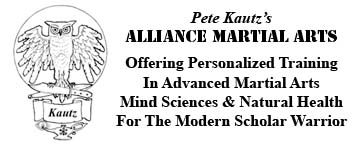|
|
Enter your e-mail address below and watch for a free weekly Training Tip on some aspect of martial arts, blade craft, conditioning, self defense, health, physical culture, history, mind training, attribute development, special offers & more |
What's New - Timeline - Articles - Techniques - Catalog - Seminars - Links - Contact Us
|
|
|
Defense Training of Methode Naturelle Previously I've written about Georges Hebert's art of Methode Naturelle (MN) which is a system of physical fitness he codified in the early 20th century and refined throughout his lifetime. In MN there are 10 families of exercise we practice. These are: Crawling Walking Running Jumping Climbing Balancing Lifting & Carrying Throwing Defense Swimming As you can see, these are all universal to human existence. You could go anywhere in the world and people would inherently know how to do these things to some degree or another. Further, each family is quite technically diverse because there are so many ways to do each of them. Take a moment and think of how many ways you can simply walk for example; you can walk in all different directions, take large or small steps, go up and down inclines, step over and under obstacles, skip, keep one foot in the lead, move your arms in various ways, etc. The family of Defense covers methods of unarmed combat. Hebert drew the techniques from Boxing, Savate, and Wrestling. (Hebert created a method of fighting with the cane as well. He considered Fencing to be part of what he called "Functional or Utilitarian Sports". These were things that were not necessarily universal to all human cultures but were useful to know. Other sports he considered functional included shooting, rowing and sailing, riding horses, driving cars, and riding bicycles.) What makes Hebert's teaching of Defense very interesting is the highly practical nature with which it was done, even by today's standards. Students were taught basic punches and kicks along with a counter for each. These moves consisted of the jab, cross and hook of Boxing along with the front, round and side kicks of Savate. They then practiced developing their form and power by striking targets. He specified using canvas dummies filled with sawdust that are positioned against a wall or suspended from various heights as well as using wooden posts suspended from various heights for specialized kick training. Once the basics were learned, students practiced sparring with one another and applying the movements for real with gloves on. This was true for both the men and women, as seen in period photos of the training. This simple, direct approach was followed when it came to grappling as well. Once the basic moves were learned students were paired off and worked competitively, trying to actually throw one another and not be thrown. Sometimes this was what we would think of as Greco-Roman and other times they wore heavy canvas jackets in what Hebert refer erred to as "Briton wrestling" where leg sweeps played a big part. Finally he taught a series of Keys or what we would call joint locks or holds such as the hammerlock and armbar to subdue an opponent. This part of the work looks like early Jujutsu but Hebert does not ever mention the Japanese art by name. Outside of direct combatives, the Defense family also includes all kinds of exercises where two or more people compete by pushing, pulling, lifting, or otherwise making body contact. This can include tug of war with a rope or pole, trying to push or pull each other over a line, and so on. In a training session Defense is usually done near the end of the workout and is followed by walking and stretching. But because of the flexible nature of MN it could be the focus of a day's work or something you skip entirely for that session. If this sounds interesting please visit the Georges Hebert MN resource page at Alliance for links to PDFs of many books and videos which you can study and learn more! Enjoy and all the best, Pete Kautz PS - Like this Article? Sign up for the Training Tips at the top of the page and get an original article like this sent to you by e-mail every week on Tuesday!
|
Check Back Next Week For A NEW
Special!
What Will It Be???
What's New - Timeline - Articles - Techniques - Catalog - Seminars - Links - Contact Us
